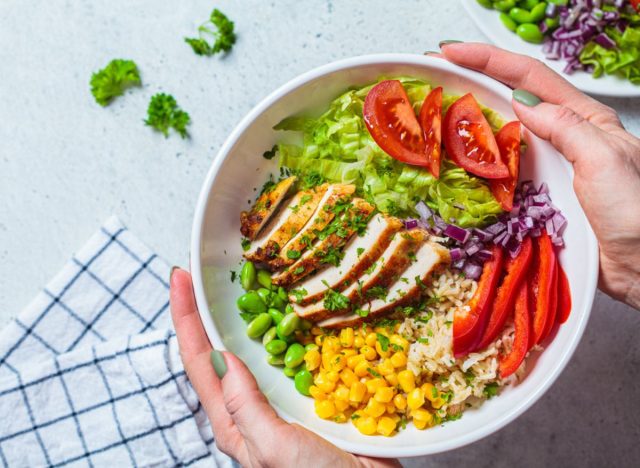If you have high blood pressure or worry about developing hypertension, pull up a chair to our breakfast table. The first and so-called most important meal of the day can put you on the right track to controlling your blood pressure with food.
High blood pressure is called the “silent killer” because there are no symptoms telling you, “Hey, go see your doctor!” It develops slowly and without warning and can lead to serious problems like heart attack, stroke, and kidney disease. The only way you know if you have hypertension is by having your blood pressure checked. But even before your numbers motivate you to act, you can start managing your blood pressure the easiest way—by eating right.
Breakfast is an excellent meal for beginning your fight against high blood pressure because there are so many commonplace breakfast items that can raise it and just as many healthier choices that can protect you against hypertension. Read on, and for more on how to eat healthy, don’t miss Eating Habits to Lose Abdominal Fat As You Age, Say Dietitians.


When your blood vessels narrow, technically called vasoconstriction, blood flow is reduced and blood pressure rises. You can counter that with a cup of tea. Research suggests that drinking lots of tea can help your blood vessels become more flexible so blood flows more easily, leading to lower blood pressure and a healthier heart. The active ingredients in tea are polyphenols. These plant compounds act as antioxidants in the body, reducing inflammation and boosting the activity of nitric oxide in the lining of the blood vessels. Nitric oxide is a vasodilator that works on the cells of the endothelium, causing blood vessels to widen, improving blood flow, and lowering blood pressure, according to a report in the journal Nutrients.
What about coffee? Caffeine is a vasoconstrictor, so caffeinated coffee can raise blood pressure. Some studies have shown that coffee consumption raises blood pressure temporarily while others suggest caffeine’s impact may be negated by other antioxidant compounds in coffee that may protect blood vessels in the same way tea’s polyphenols do.


You might think sprinkling salt on your scrambled eggs is a bad habit to break, but the saltshaker isn’t the BP bomb it’s been made out to be. There are much worse habits than a few shakes of flavoring on your eggs. “Instead, processed foods are where most of us get too much sodium (the primary component of salt) in our diet,” says Eathis.com medical review board member Molly Hembree, MS, RD, LD, a registered dietitian. “This means we should be shying away from frozen meats like bacon and sausage (even if it’s turkey!), processed cheeses, and frozen breakfast sandwiches.”
For example, a Jimmy Dean Bacon, Egg and Cheese Biscuit Breakfast Sandwich packs 720mg of sodium per serving. That’s almost half the amount of sodium that the American Heart Association recommends most adults limit their sodium intake to per day. Dean’s Delights Spinach & Egg White made with a plant-based “meat” patty (sounds healthy, no?) contains even more sodium at 800mg. Better breakfast choices include fruit, whole-grain cereals, avocado toast and yogurt, says Hembree.


You’ve heard that eating half a grapefruit before meals can help you lose weight, but did you know that habit can help your heart? “The best food to temper blood pressure to enjoy at breakfast is citrus like oranges, grapefruit, lemons and other citrus options,” says medical review board member and registered dietitian Julie Upton, MS, RD, CSSD, co-founder of Appetite for Health. Or drink a small glass of 100% orange juice. “Citrus is rich in potassium which helps lower blood pressure and citrus is sodium-free,” she says. “Also, there are bioactive compounds in citrus that help improve heart health.”
READ RELATED: The U.S. Is Stockpiling Smallpox Vaccines as Monkeypox Outbreak Grows


“Milk and other dairy products like yogurt are rich in potassium and other nutrients that help lower blood pressure,” says Upton. Some of those other nutrients include calcium, magnesium, zinc, phosphorus, and vitamins A, B-12, and riboflavin. While Upton recommends low-fat milk and yogurt, whole milk products may have a similar effect on blood pressure. One study in a 2019 edition of the journal BMJ Open Diabetes Research & Care found that having at least 2 servings daily of any dairy product was associated with an 11 to 12% lower risk of having both diabetes and high blood pressure. Higher intake of dairy foods, especially whole-fat dairy, was associated with a lower prevalence of metabolic syndrome and with a lower risk of developing hypertension and diabetes, the researchers found.


You’ll get fiber, protein, a full belly that’ll stay satisfied, and a boost to your heart health, as well. A 2019 meta-analysis of 70 studies in Advances in Nutrition confirmed the positive health benefits of eating pulses. Pulses are beans, like chickpeas, lentils, peas, and other legumes. The review found that regularly consuming pulses can lower blood pressure and reduce the risk of cardiovascular disease.


Or drink a small glass of tart cherry juice. Studies show that tart cherries can help lower blood pressure and reduce the risk of cardiovascular disease and stroke thanks to their abundance of nutrients like polyphenols and potassium.


Cherries, oranges, or bananas for that matter, aren’t your only high potassium breakfast fruits. A cup of watermelon packs 170 mg of the bp-lowering electrolyte potassium. One study in the American Journal of Hypertension demonstrated watermelon’s health potential. Researchers found that when obese men and women suffering from hypertension consumed watermelon extract, their blood pressure dropped even when the people were put in stressful situations.


DASH stands for Dietary Approaches to Stop Hypertension. It’s an effective healthy eating plan specifically designed for people who have high blood pressure or want to avoid it and it works, says medical review board member Amy Goodson, MS, RD, CSSD, a registered dietitian and author of The Sports Nutrition Playbook. The DASH Diet focuses on whole foods like fruit, vegetables, whole grains, lean protein, and healthy fats from fish, nuts, seeds, and monounsaturated oils. Studies indicate that the eating plan can lower blood pressure in as few as two weeks. While DASH limits foods high in sodium and saturated fats, the diet’s blood pressure-lowering power may be due to the fact that DASH foods are high in potassium, calcium, and magnesium—all key minerals that regulate blood pressure.
Some DASH foods to add to your breakfast include apples, bananas, oranges, strawberries, spinach, and eggs.
Source:







